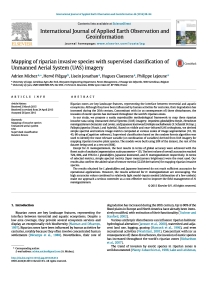Michez A., Piégay H., Lisein J., Claessens H., Lejeune P.
Riparian zones are key landscape features, representing the interface between terrestrial and aquaticecosystems. Although they have been influenced by human activities for centuries, their degradation hasincreased during the 20th century. Concomitant with (or as consequences of) these disturbances, theinvasion of exotic species has increased throughout the world’s riparian zones.In our study, we propose a easily reproducible methodological framework to map three riparianinvasive taxa using Unmanned Aerial Systems (UAS) imagery: Impatiens glandulifera Royle, Heracleummantegazzianum Sommier and Levier, and Japanese knotweed (Fallopia sachalinensis (F. Schmidt Petrop.),Fallopia japonica (Houtt.) and hybrids). Based on visible and near-infrared UAS orthophoto, we derivedsimple spectral and texture image metrics computed at various scales of image segmentation (10, 30,45, 60 using eCognition software). Supervised classification based on the random forests algorithm wasused to identify the most relevant variable (or combination of variables) derived from UAS imagery formapping riparian invasive plant species. The models were built using 20% of the dataset, the rest of thedataset being used as a test set (80%).Except for H. mantegazzianum, the best results in terms of global accuracy were achieved with thefinest scale of analysis (segmentation scale parameter = 10). The best values of overall accuracies reached72%, 68%, and 97% for I. glandulifera, Japanese knotweed, and H. mantegazzianum respectively. In termsof selected metrics, simple spectral metrics (layer mean/camera brightness) were the most used. Ourresults also confirm the added value of texture metrics (GLCM derivatives) for mapping riparian invasivespecies.The results obtained for I. glandulifera and Japanese knotweed do not reach sufficient accuracies foroperational applications. However, the results achieved for H. mantegazzianum are encouraging. Thehigh accuracies values combined to relatively light model-inputs needed (delineation of a few umbels)make our approach a serious contender as a cost-effective tool to improve the field management of H.mantegazzianum.
Consultez la notice complète de l’article sur ORBi

